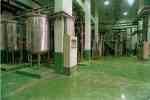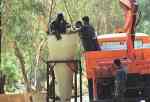
Click on any Country below,
or click on the upward pointing arrow to go to the Main page of the article.





The Iraqi Program:
The Iraqi biological weapons program became know to the world after the
forced inspections of Iraqi weapons facilities by UN inspectors (UNSCOM) after the Gulf war.
After the Gulf war, Iraq stated that, in the Government had adopted a policy to
acquire biological weapons in 1974. In 1975, a research and development
biological weapons program was established under the Al Hazen Ibn Al Haytham
Institute at a site located in Al Salman. The work was poorly directed. Coupled
with a lack of appropriate facilities and equipment, it was said the Institute
achieved little and it closed in 4 years.
The work however was continued by Muthanna State Establishment, which was
Iraq's primary chemical weapons facility as well. The program again shifted to
Al Salman when the biological weapons program began to hinder the progress of
the chemical weapons program at Muthanna.



Images:
Please click on the images to view larger versions.
1) One of the buildings of the
Al-Hakam facility after most of the complex was destroyed by UNSCOM inspectors.
2) Iraqi fermenters at the Al-Hakam complex (UNSCOM photo)
3) A UNSCOM team examining a chemical weapons missile warhead somewhere in Iraq.
(UNSCOM photo)
In order to set up a dedicated facility for Biological weapons research, the
Iraqis in 1988 set up a new site at a location now known as Al Hakam. The
project was given the designator "324". It was at this site that the
most advanced Iraqi research on Biological weapons was carried out. It was the
primary manufacturing centre of the Iraqi program until the Gulf war began.
The Iraqis did not limit their research to Anthrax and botox. The other
agents under research included Cl. Perfringens (the agent which causes gas
gangrene), Alfatoxin (a highly carcinogenic fungal product) and ricin (a plant
product that causes bleeding in the lungs or haemmorhagic pneumonia when
inhaled).
After Iraq's invasion of Kuwait, weaponization of biological warfare agents
began on a large scale at Muthanna. Artillery bombs were selected as the
delivery means for these weapons. After the war, it was found that 100
bombs were filled with botulinum toxin, 50 with anthrax and 16 with aflatoxin.
In addition, 25 Al Hussein warheads, to be fitted on top of the scud missiles,
were filled with biological agents.
All in all, after the Gulf war, Iraq declared :
1) 19,000 litres of concentrated botulinum toxin
2) 8,500 litres of concentrated anthrax
3) 2,200 litres of concentrated aflatoxin
After the forced UNSCOM inspection of Iraqi weapons facilities, most of these
facilities were either  sealed off or placed under heavy surveillance. Hence, the
Iraqi biological program is virtually over now. However, even the US senate
research service admits that it is quite possible that Iraq has hidden some
biological warheads and missiles for future use.
sealed off or placed under heavy surveillance. Hence, the
Iraqi biological program is virtually over now. However, even the US senate
research service admits that it is quite possible that Iraq has hidden some
biological warheads and missiles for future use.
Image:
UNSCOM inspectors installing security cameras at the Al-Hakam complex. (UNSCOM
photo)

![]()